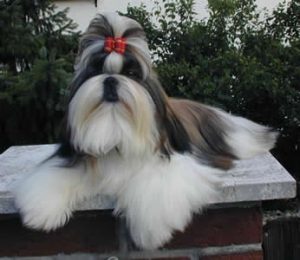
The Shih Tzu is a breed of small companion dog of very ancient dog type, with long silky fur. The breed originated in China, possibly by way of Tibet. The name is both singular and plural.
Appearance
A small dog with a short muzzle and large deep dark eyes, with a soft long, double coat, the Shih Tzu stands no more than 26.7 cm (10 1/2 in.) at the withers and with an ideal weight of 4.5 to 7.3 kg (10 to 16 lbs). Drop ears are covered with long fur, and the heavily furred tail is carried curled over the back. The coat may be of any colour, although a blaze of white on the forehead and tail-tip is frequently seen. The Shih Tzu is slightly longer than tall, and dogs ideally should carry themselves “with distinctly arrogant carriage”.
The traditional long silky glossy coat that reaches the floor requires daily brushing to avoid tangles. Often the coat is clipped short to simplify care, in a “puppy clip”. For conformation showing, the coat must be left in its natural state, although trimming for neatness around the feet and anus is allowed. Because Shih Tzu noses are small and flat, owners often wipe the dog’s face with a damp paper towel to remove food remnants after the dog has eaten a meal. Shih Tzu may be trained to drink out of a water bottle. The water bottle keeps the face clean and dry preventing red yeast from growing on the Shih Tzu beard and moustache. Owners often tie strands of hair from the Shih Tzu’s head into a pony tail that sticks up.
Temperament
The Shih Tzu is a friendly lap dog that at one time was bred to be a companion dog for Chinese royalty. Some say living in the imperial palace gave the Shih Tzu an arrogant quality, although they also display qualities of devotion and adaptability. They are not afraid to stand up for themselves. They tend to be sweet, playful, and trusting as well. It ranks 70th in Stanley Coren’s The Intelligence of Dogs, considered one of the lowest degree of working/obedience intelligence (trainability). They don’t need as much exercise as larger dog breeds, but do suffer from the same difficulties as most small breed dogs due to having a smaller bladder.
—————————————————————————————————————–
CARING FOR YOUR DOG NEWSLETTER – Delivered Directly To Your Inbox – Starting Immediately – SIGN UP FOR FREE TODAY
—————————————————————————————————————–
